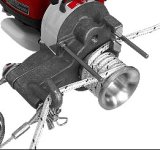iointerrupt
Member
- Joined
- Sep 12, 2011
- Messages
- 46
So I log maybe a dozen trees a year, and due to living on horribly rocky property, just getting to the trees is half the battle. A winch is the obvious answer, but the electric ones aren't really up to the task, and a Farmi-style winch cost too much for how little I'd use it. Thus I eventually found the idea of a PTO Capstan winch appealing, and decided to give that a try.
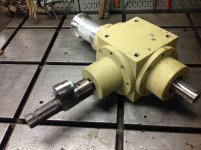
The heart of my winch is this gear box. It's a 4:1 reduction, with a ~1" input shaft and 2 ~1.375" output shafts (shafts are actually metric sized). It's new-old stock, costing me $75 at the local scrap yard. I wish I could tell you more about it, but there is not a single manufacturers marking on it. Given it's weight and shaft sizes, I figured it'd tolerate the abuse a winch would give it, it's at least three times the size of a typical PTO snowblower gearbox.
In that picture, you can see the first winch drum I made, as well as the splined PTO adapter already installed. I copied the design of the PTO adapter from my snowblower, it has a 7/16" bolt, designed to shear out at at around 20HP of input, and disconnect gearbox from the PTO. So far in use, the winch is impossible to stall, the ropes just slip instead.
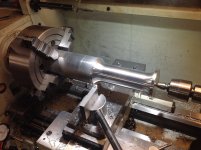
The winch drums I turned from big chunks of aluminum. To get the nice end flares, I had to also build a ball/radius turner. In the end I wished I had made the end flanges even bigger, as the rope wants to jump off them sometimes. A slight knurl on the drums helps with grip.
I had read a comment somewhere on TBN, that aluminum drums don't hold up in use. And they are right. The extreme pressure the rope is under, when wrapped around the drum, will cause any dirt on the rope to chew into the drum. So far it isn't been a show-stopper, easy enough to file the drums smooth again. But I see making steel drums in my future.
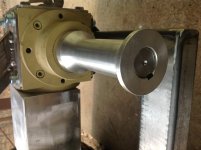
One drum is 3", the other drum is 5". In theory the 3" drum winds the rope in slower, but has far more torque than the 5". The equations for winch drum torque is a bit counter-intuitive, smaller drums make more torque. Look up winch equations before making yours. In actual practice, I've noticed no real difference between the two, and just use whatever drum is convenient.
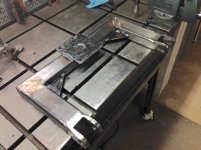
With the gearbox and drums done, I started building a frame to hold it. The main box is 3"x2" 3/16" rectangular tube. It's stupid overkill for this, but I had 20' of it laying around. Originally I tested the winch with just this upper frame, no ground-engaging bits. It would mostly just cause the tractor to be dragged toward the log.
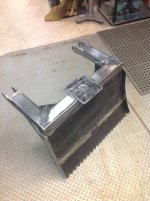
So needing a "ground brake", I mostly just copied what I saw on Farmi-style winches. Upper plate is 1/8", lower plate is installed at a bit of a angle, made of 3/16". Teeth on the lower plate probably not needed, but, teeth are cool.
When in use, I find the tractor slides about 3-6" inches until the teeth have dug in. But once they are dug in good, tractor is planted doesn't move anymore, no matter what.
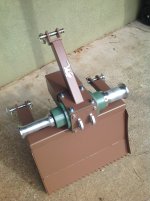
In some sense, the entire winch is built around the gearbox. Since the gearbox had mounting holes on all sides, I used them. The front has some chain hooks to attach logs to. The back has a PTO guard I bent up. And naturally the top-link just bolts right to the top. This particular top-link design bent a bit a little in use, I have a new one made but haven't tested it out yet.
For rope, I first tried 3/8" synthetic winch rope. One trip through the winch, and that rope is now pancake flat. Next I tried 5/8" double braided nylon rope. That worked well until outer cover got a small tear on it, and then it quickly unraveled. Finally I settled on 5/8" three-strand-twisted rope. It is holding up the best, but nevertheless the winch is very hard on any rope you run through it. I expect to replace the rope fairly frequently. (5/8 x 1�� NYLON ANCHOR ROPE/ DOCK LINE W/ SS Thimble ***MUST READ DESCRIPTION** | eBay)
Winch In Action Movie
Finally, in use, the winch works about as well as I expected. I haven't attempted to measure it's pull strength, but I believe the math on paper said 4000lbs.
I mostly pull 10', 20" diamater sized logs with it, weighing about 1000lbs each. If there are no obstructions, it pulls them like they aren't even there. More challenging pulls it will do too, I managed to rip a 200lb rock buried 16" deep out with it. On the other hand, it does eventually run out of torque. Hit a really big rock at a bad angle, and the rope will just slip. But for un-obstructed pulls, I think it will easily do everything I ask of it.
The pulling speed in the video looks slow, but I almost always use it with the tractor near idle and never feel the need for it to go faster. The total time waiting for the winch is a rounding error compared to all the other work involved.
One other thing I should note, is there is no way this thing is as safe as a "normal" winch. At least twice I've gotten the rope tangled on the drum, and once tangled it will start to self-feed. This leaves you diving for the PTO shut off switch. It could really use some type of disconnect clutch, just for safety reasons.
As well I should mention rope stretch. Some of the nylon rope I tested with the winch had a massive amount of stretch to it. You could start winching, pull 5' of rope through the winch, and your log wouldn't have moved an inch. Then suddenly it would "unload", and the log would jump 5'. Then the process would repeat itself. So obviously, use low-stretch rope if you can.
That all said, for the ~$300 worth of material I have into it, hard to beat. Capstan winches are super affordable if you have the tools to build them.

The heart of my winch is this gear box. It's a 4:1 reduction, with a ~1" input shaft and 2 ~1.375" output shafts (shafts are actually metric sized). It's new-old stock, costing me $75 at the local scrap yard. I wish I could tell you more about it, but there is not a single manufacturers marking on it. Given it's weight and shaft sizes, I figured it'd tolerate the abuse a winch would give it, it's at least three times the size of a typical PTO snowblower gearbox.
In that picture, you can see the first winch drum I made, as well as the splined PTO adapter already installed. I copied the design of the PTO adapter from my snowblower, it has a 7/16" bolt, designed to shear out at at around 20HP of input, and disconnect gearbox from the PTO. So far in use, the winch is impossible to stall, the ropes just slip instead.

The winch drums I turned from big chunks of aluminum. To get the nice end flares, I had to also build a ball/radius turner. In the end I wished I had made the end flanges even bigger, as the rope wants to jump off them sometimes. A slight knurl on the drums helps with grip.
I had read a comment somewhere on TBN, that aluminum drums don't hold up in use. And they are right. The extreme pressure the rope is under, when wrapped around the drum, will cause any dirt on the rope to chew into the drum. So far it isn't been a show-stopper, easy enough to file the drums smooth again. But I see making steel drums in my future.

One drum is 3", the other drum is 5". In theory the 3" drum winds the rope in slower, but has far more torque than the 5". The equations for winch drum torque is a bit counter-intuitive, smaller drums make more torque. Look up winch equations before making yours. In actual practice, I've noticed no real difference between the two, and just use whatever drum is convenient.

With the gearbox and drums done, I started building a frame to hold it. The main box is 3"x2" 3/16" rectangular tube. It's stupid overkill for this, but I had 20' of it laying around. Originally I tested the winch with just this upper frame, no ground-engaging bits. It would mostly just cause the tractor to be dragged toward the log.

So needing a "ground brake", I mostly just copied what I saw on Farmi-style winches. Upper plate is 1/8", lower plate is installed at a bit of a angle, made of 3/16". Teeth on the lower plate probably not needed, but, teeth are cool.
When in use, I find the tractor slides about 3-6" inches until the teeth have dug in. But once they are dug in good, tractor is planted doesn't move anymore, no matter what.

In some sense, the entire winch is built around the gearbox. Since the gearbox had mounting holes on all sides, I used them. The front has some chain hooks to attach logs to. The back has a PTO guard I bent up. And naturally the top-link just bolts right to the top. This particular top-link design bent a bit a little in use, I have a new one made but haven't tested it out yet.
For rope, I first tried 3/8" synthetic winch rope. One trip through the winch, and that rope is now pancake flat. Next I tried 5/8" double braided nylon rope. That worked well until outer cover got a small tear on it, and then it quickly unraveled. Finally I settled on 5/8" three-strand-twisted rope. It is holding up the best, but nevertheless the winch is very hard on any rope you run through it. I expect to replace the rope fairly frequently. (5/8 x 1�� NYLON ANCHOR ROPE/ DOCK LINE W/ SS Thimble ***MUST READ DESCRIPTION** | eBay)
Winch In Action Movie
Finally, in use, the winch works about as well as I expected. I haven't attempted to measure it's pull strength, but I believe the math on paper said 4000lbs.
I mostly pull 10', 20" diamater sized logs with it, weighing about 1000lbs each. If there are no obstructions, it pulls them like they aren't even there. More challenging pulls it will do too, I managed to rip a 200lb rock buried 16" deep out with it. On the other hand, it does eventually run out of torque. Hit a really big rock at a bad angle, and the rope will just slip. But for un-obstructed pulls, I think it will easily do everything I ask of it.
The pulling speed in the video looks slow, but I almost always use it with the tractor near idle and never feel the need for it to go faster. The total time waiting for the winch is a rounding error compared to all the other work involved.
One other thing I should note, is there is no way this thing is as safe as a "normal" winch. At least twice I've gotten the rope tangled on the drum, and once tangled it will start to self-feed. This leaves you diving for the PTO shut off switch. It could really use some type of disconnect clutch, just for safety reasons.
As well I should mention rope stretch. Some of the nylon rope I tested with the winch had a massive amount of stretch to it. You could start winching, pull 5' of rope through the winch, and your log wouldn't have moved an inch. Then suddenly it would "unload", and the log would jump 5'. Then the process would repeat itself. So obviously, use low-stretch rope if you can.
That all said, for the ~$300 worth of material I have into it, hard to beat. Capstan winches are super affordable if you have the tools to build them.
